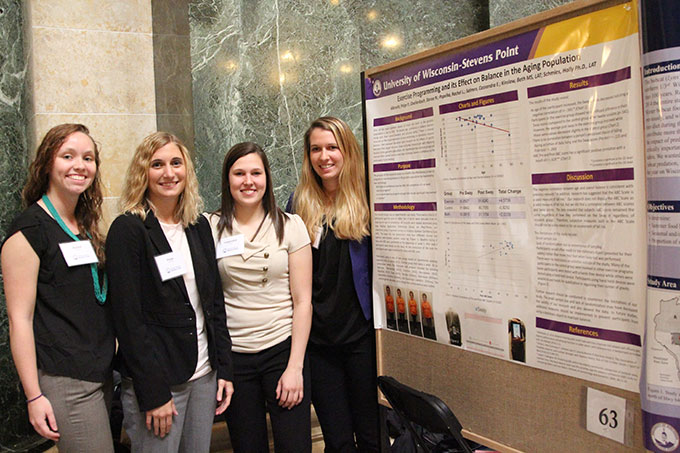

Athletic training students from the University of Wisconsin-Stevens Point are shared research findings during the 12th annual Posters in the Rotunda event Wednesday, April 22, at the State Capitol in Madison.
Studies show that undergraduate research leads to better job readiness, encompassing a broad range of student talents, interests and skills across academic disciplines. UW leaders believe broader participation in undergraduate research will provide students with the knowledge and skills they need for 21st century jobs, preparing graduates to succeed in a world that values innovation, problem-solving, teamwork and collaboration.
Posters in the Rotunda is a wonderful opportunity to learn about the exciting research going on throughout the state and to support Wisconsin students and faculty members who contribute to the state’s strong economic future. The University of Wisconsin System is a national leader in undergraduate research, which contributes to the state’s priorities, including retention, graduate rates, workforce and economic development.

Rachel Popelka, Cassandra Salmen, Danae Daellenbach, Paige Albrecht – School of Physical Education & Athletic Training
“Exercise Programming and its Effects with Balance in the Aging Population”
“The Correlation Between FMS Scores and Athletic Injuries in Collegiate Athletes”

Project Abstract: The purpose of our study is to determine if there is a correlation between a Functional Movement Screen (FMS) score and athletic injury occurrence. FMS is a ranking and grading system used to identify a participant’s ability to complete a series of seven functional movement patterns. Participants FMS scores will be determined through the utilization of a FMS screening prior the beginning of their collegiate athletic season. Upon completion of the athletic season, statistical analysis will be completed to determine if there is a correlation between a participant’s FMS score and injury incidence. If the results show a positive correlation between FMS scores and injury occurrence, at-risk individuals can be identified and a preventative program will be implemented to decrease injury prevalence. This research will be beneficial in athletics by identifying and preventing injury risk and decreasing time loss due to injury in all levels of sports.
